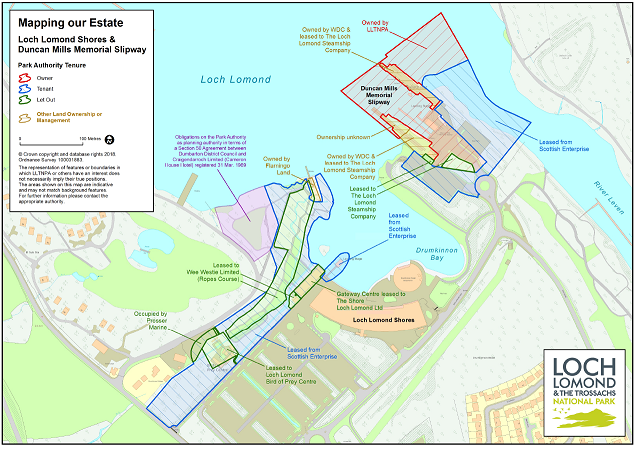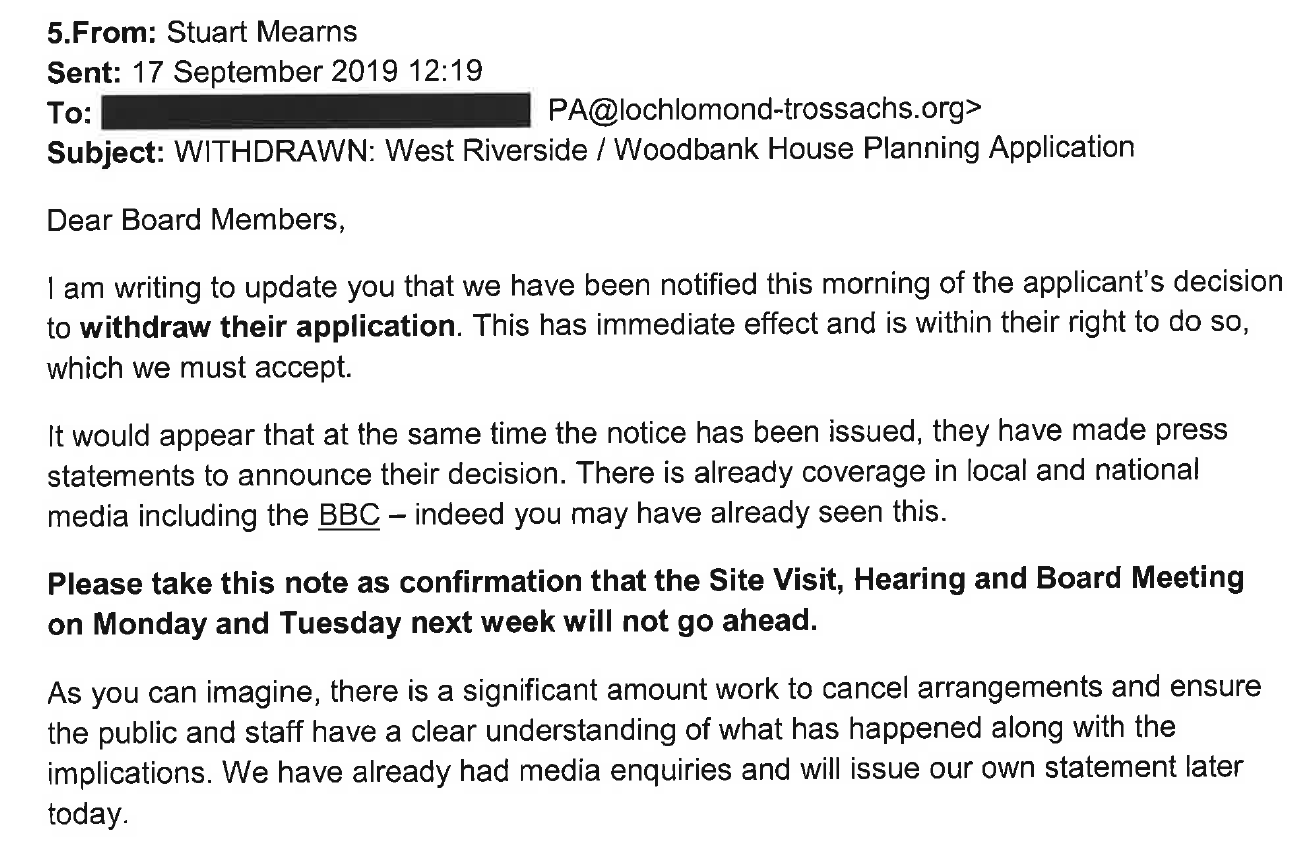
A month after the Flamingo Land Planning Application was withdrawn on 17th September (see here), I submitted an information request to clarify further the Loch Lomond and Trossachs National Park Authority Board’s involvement in the whole process. EIR 2019-022 Response arrived a couple of weeks ago. It provides several insights into the Flamingo Land Planning debacle, the most important of which is about the land owned by the National Park which was included in the Planning Application.
LLTNPA land on the Riverside site – who agreed Flamingo Land could use it?
In September, while considering the proposed Moulsdale Properties development at Tarbet, I questioned publicly the inclusion of land owned by the LLTNPA in private planning applications, including that of Flamingo Land (see here). Early in the summer I had discovered that National Park land had been included in the Flamingo Land development proposal and asked the LLTNPA then:
“how it is that land owned or leased by the Park Authority is included within the Planning Application”?
The LLTNPA’s response to this on 6th June (See here – June – National Park Authority and West Riverside) was:
“We have not agreed that the land occupied by the Park Authority can be included in the area covered by the West Riverside planning application. [Comment: relieved to hear it]. It may be helpful to explain that in Scotland it is not necessary to be the owner of land to submit a planning application in relation to it.
A planning applicant may submit a certificate to the planning authority showing the owner of the land and any agricultural tenants, and whether the applicant has notified them of the application. The Landowner does not need to be aware of a planning application until notification is sent out.
The Planning Officer became aware of the inclusion of occupied by the Park Authority and requested further information about this from the agent, in the letter sent on 8th August 2018 to request further information. This letter is available via our online planning portal, using the reference 2018/0133/PPP. Please note the inclusion of this point at the end of the letter, this matter was initially raised with the agent in July 2018. [Comment: this is all true but fails to say that Scottish Enterprise/Flamingo Land appear to have only formally notified the LLTNPA as landowner about this in a landowner notification form dated 17th April, i.e 8 months later].
For the avoidance of doubt we can confirm that there have been no agreements put in place with the applicants, Scottish Enterprise and Flamingo Land, or with the agent acting on their behalf, regarding the land occupied by the Park Authority that has been included in the planning application which is currently under consideration.”
Following this, a paper to the LLTNPA meeting on 17th June, set out how the Park would decide the Flamingo Land Application and in doing so noted (para 5.3) that:
“This application has been submitted jointly by two applicants, Flamingo Land Limited and Scottish Enterprise. It should also be noted that a small area of the application site, next to the Duncan Mills Memorial Slipway at Pier Road, is under the ownership of the National Park Authority. The Park Authority also has other interests within the application site as it occupies and sub-leases other areas. Planning law allows applications to be made on land not owned by the applicant provided the necessary notifications to other parties have been made. The Park Authority’s ownerships and other interests as stated above are a separate matter from its duty and responsibilities as a planning authority to consider the planning merits of the proposals in its determination of the application.”
Agreed the two are separate matters. This, however, leaves unanswered the question who or how had it been agreed that the Park’s own land should be included in the planning application without any comment being made on this? Just suppose you owned a small piece of land on which a developer wanted to build a giant leisure comment, would you let the planning application just go ahead without comment or any attempt to negotiate with the developer? Yet that’s just what Board Members seem to have done.
The paragraph from the June Board Report was then repeated word for word in the full report on the Planning Application (after para 4.2.4) . This raised the question whether the Board had discussed the inclusion of land belonging to the Park and the public sometime in-between these two meetings. Hence my FOI. The response helpfully closes the information gap and shows there no such discussions:
“There were no briefing sessions, meetings, emails or papers for the Park Authority Board in relation to land owned and leased by the Park Authority which was included in the West Riverside planning application. However, paragraph 5.3 of the paper for Agenda item 6 from the Park Authority Board meeting held on 17th June 2019 notes the land interests of the Park Authority in the application site.”
So we now know for definite that the LLTNPA Board NEVER discussed whether the land they owned should be included in Scottish Enterprise’s and Flamingo Land’s Planning Application. That is wrong. It raises a number of serious questions:
- How can a public authority have allowed its land to be put on the table for the benefit of a private developer without any scrutiny by their Board, let alone the Public?
- Which members of the senior staff team were responsible for this?
- From a purely procedural perspective, did senior staff consider the risks of the LLTNPA Board approving the application but then separately deciding NOT to make the land it owns available? In such a scenario the LLTNPA would have risked being sued for £millions for wrecking the development.
- Did senior staff follow the Guidance set out in the Scottish Public Finance Manual section on property disposal? If so, what was the response of the civil servants?
These questions need to be answered. Decisions about the future use of the LLTNPA’s land within the Riverside Site may well be crucial to the viability of any revised Planning Application from Scottish Enterprise/Flamingo Land.
Board and staff responsibility for the Flamingo Land Planning Application
I had wondered whether Board Members might have been briefed at various times about the Flamingo Land Planning Application. The Information Response and emails provided as an Appendix (see here) show they weren’t – at least not formally and not in writing.
While I am still generally sceptical about what the LLTNPA Board does because of its terrible record of taking decisions in secret (13 meetings about the camping byelaws before they were approved) these emails do appear to reflect levels of Board involvement. I have heard elsewhere a Board Member say they were NOT allowed to say anything about the Flamingo Land Planning Application in case this prejudiced the decision. Effectively staff have told them to be silent – the emails which tell Board Members to refer any enquiries about the Application to staff re-inforce this. This perhaps explain why Board Members never raised any of the obvious public interest questions about the inclusion of the Park’s own land in the Planning Application.
What all this tells you I believe is that the entire responsibility for addressing issues with Scottish Enterprise and Flamingo Land, including their plans for the land owned and leased by the LLTNPA, lay with senior staff.
The aftermath of the application being withdrawn
The emails reveal that Flamingo Land and Scottish Enterprise didn’t even bother to let LLTNPA staff know they were withdrawing the application before putting out a news release.

After all LLTNPA staff had done to smooth the way application, Stuart Mearns’ frustration is palpable. Its not nice to be treated like a second class citizen of no importance. Perhaps this will encourage LLTNPA staff to be less accommodating to Scottish Enterprise and Flamingo Land next time?
What needs to happen?
The LLTNPA Board must sort out how its going to decide in future about whether or how its land might be included in private sector developments. While anyone can submit a private application, the need for the LLTNPA Board to take a stance on this should be obvious: what will happen if a group of people decide to submit an alternative application? Or is it just first served? Any decision making process on such land, whether at Tarbet or Balloch, must be based on public consultation and engagement about how the wider public would like to see the LLTNPA use the land it owns.
The wider issue, however, is about how the Scottish Government is still allowing public land to be disposed of by the back door, with no real public consultation and without local communities being given any proper chance to take them over. That’s a Scotland wide issue. There area also specific questions about why the Scottish Government is allowing nationally owned land to be sold off in National Parks (see here for Ewich Forest at Crianlarich).
Its time to raise questions about public ownership of land: does the Scottish Government believe that flogging off public assets or allowing them to be used by commercial concerns without any consideration of the public interest is really what Scotland should be all about?

I don’t think that’s right….unelected officials telling Board members not to comment. I got that with WDC too. I raised that app with WDC C,llor/Board member Diane Docherty and got no response. Then I think I sent you/others the to and fro between me and the then MSP Gill Paterson…who also refused to comment. Then I took it up with Ken McIntosh, my regional MSP. I asked him where was the Standards/Code of Conduct ruling on this. He came back saying there was none…no duty either way. It was up to the elected representatives themselves whether to comment on planning applications or not. I raised it with Jackie Baillie and Jim Bollan for sure. What is the point of electing and paying for Board members if all they’re doing is to duplicate and replicate what the officials say? They’re supposed to represent their constituents and they never do and don’t know how.
It is normal for a member of a planning committee not to express views about a planning application in advance of the committee’s decision on the application, and then when it comes to a vote, to vote one way or another. If they did express a view in advance, they would not be entitled to vote due to the perception of bias. Unfortunately this sensible approach, which I am pretty sure is recommended by a code of conduct for councillors I can’t immediately put my hands on, is being quietly, and without justification, extended to councillors and other local elected representatives who have no formal say in the decision – to the frustration of both the public and those politicians, and to the detriment of public discourse.